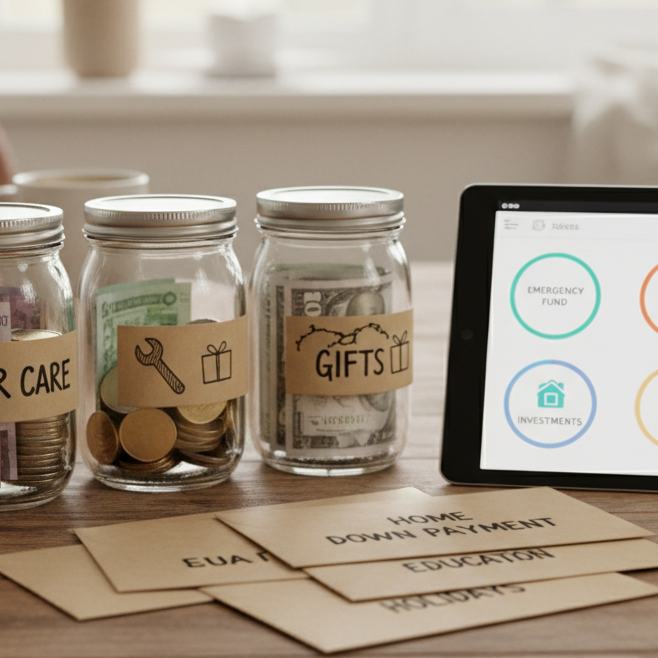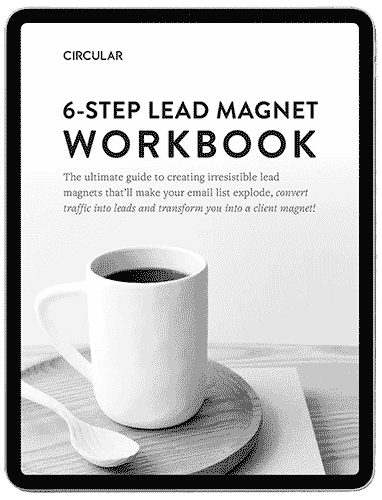Imagine this: a coworker texts you from the repair shop, heart racing, because her car needs $780 she hadn’t planned for. Two weeks later, holiday gifts hit, then school photos, then the dog’s meds. Sound familiar? That pileup steals focus, sleep, and your hard-earned momentum.
Here’s the fix you can actually stick with: a sinking fund. A sinking fund is a dedicated savings plan for predictable future expenses. Think car care, travel, annual fees, and celebrations. Small amounts, set aside on purpose, before life throws the bill at you.
Sounds like a great thing to have in place, right?
So let’s dig into what sinking funds are, why they matter for busy women with big goals, how to set them up in minutes, and real examples you can copy. You’ll see how this simple system lowers stress, helps you avoid debt, and gives you more control over your money.
If you’re an ambitious professional with a full calendar and clear targets, you’re in the right place. We’ll keep it simple, quick, and doable. Start small, build confidence, and watch the “uh-oh” bills turn into “already covered.” Ready to breathe easier?

What Is a Sinking Fund and Why Does It Fit Your Busy Life?
Think of a sinking fund as your money GPS for known costs. It is money you set aside in small, regular amounts for a specific future expense with a date attached. That is the plain answer to what is a sinking fund. Annual insurance, a vacation, new tires, your sister’s wedding, a work conference fee, flights for the holidays, all fair game.
Here is why you should have a sinking fund in plain English:
- it smooths out irregular expenses so you are not hit all at once
- it helps you avoid borrowing for planned buys
- it keeps your emergency fund for true surprises
- it adds structure to your goals with clear dates and amounts
You plan, you contribute, you pay in cash when the bill arrives. Simple, calm, done.
Who is this for? Everyone really but especially busy, ambitious women with steady income and uneven costs. If you juggle kid activities, pet care, and family events, a sinking fund keeps the chaos from draining your focus. When does it make sense? If you have recurring big bills or time-based goals, start now. If high-interest debt is taking over, prioritize that while layering in small sinking funds for essentials like car maintenance and annual fees.
Quick picture: your company announces a conference in six months, total cost around 900 dollars. Set aside 150 dollars a month, book without stress, keep your emergency fund intact, and feel like the CFO of your life. That is the power move. Expect more peace of mind, better budgeting, and steady progress on the dreams that matter.
How Sinking Funds Differ from Emergency Funds and General Savings
Every dollar needs a job, not to be shoved in a junk drawer. Here is a fast comparison chart you can use right away.
| Account Type | Purpose | Timing | Example |
| Sinking fund | Planned, specific expense | Known date or season | Car tires in 4 months, annual insurance, vacation |
| Emergency fund | True surprises, protect stability | Unknown, anytime | Job loss, urgent medical bill, broken furnace |
| General Savings | Unspecific, flexible buffer | Open-ended | Extra cushion, future options |
Let’s make it REAL simple to tell what expense belongs where. You know your tires will need replacing before winter, that is a sinking fund. You wake up to a sudden medical bill after a late-night ER visit, that is an emergency fund. General savings is extra padding without a target, helpful but easy to raid.
If you are paying off high-interest debt, pause most sinking funds to free up cash, then keep tiny, essential ones so you do not slide back into debt. For example, 40 to 60 dollars a month for car care or annual fees can prevent a new card swipe.
Pros you will feel fast:
- Builds discipline and clear habits.
- Earns interest when kept in a high-yield savings account (I’m partial to Ally for sinking funds – you can click here for my referral link).
- Prevents lifestyle creep since you spend on purpose, not impulse.
- Protects the emergency fund, so real crises get covered.
Cons (sort of) to watch for:
- Requires planning and a bit of tracking.
- Can feel restrictive if you create too many categories.
To avoid the cons, start with 3 to 5 categories you know are coming. Examples you can steal: car maintenance, gifts, travel, medical copays, professional dues, or conferences. Fund them monthly, review quarterly, and adjust. You will see stress drop and control rise, which is exactly the point.
Step-by-Step Guide to Setting Up Your Sinking Funds
You want a simple system that runs in the background and keeps you ready. Here is how to set up a sinking fund step by step, start to finish. Think small, steady transfers that hit your goals on time, then reset and repeat.

How it works in plain terms:
- Save small amounts regularly toward a known cost and date.
- Use the funds on schedule, then replenish right away for the next cycle.
- Keep the money in a high-yield savings account (HYSA) or bank subaccounts with nicknames so you can track at a glance.
Quick timeline you can follow:
1. Start now with your top 5 to 8 categories.
2. Pick a target spend date for each.
3. Auto-transfer the monthly amount on payday.
4. Spend from the fund when due.
5. Reset the target and keep going.
Best accounts for a sinking fund:
- HYSA for interest and easy transfers.
- Bank subaccounts or buckets (Ally has an awesome bucket/cash envelope feature) with nicknames like “Car Insurance” or “Holidays.”
Set it up in six clean steps:
- Review past 12 to 24 months. Scan statements for irregular costs, like insurance, travel, medical copays, pro dues, kids’ activities, and gifts.
- List categories with targets and dates. Add any balances you already have.
- Do the math. Monthly amount equals (total needed minus current balance) divided by months left. Add a 10% buffer to cover price bumps or shipping.
- Choose where to keep it. One HYSA with labeled buckets or several subaccounts with clear nicknames.
- Automate. Set transfers on payday. Add calendar alerts for due dates and renewal windows.
- Track quarterly. Adjust amounts, close unused categories, and celebrate wins.
Methods to pick your monthly amount:
- Fixed for annual bills: Split yearly costs by 12 months, like 50 dollars monthly for 600 dollar annual dues.
- Deadline back-calculation: Total needed divided by months left.
- Percentage of variable income: Send 5% to 10% of freelance or bonus income to your top fund.
- Per-paycheck split: If you are paid twice a month, split the monthly amount in half.
When money is tight, set priorities:
- Safety first: Home repairs, car maintenance, insurance. Guard your stability.
- Time-sensitive next: Known deadlines like taxes or conference registrations.
- Nice-to-haves can wait a month if needed.
Rules after you spend:
- Replenish as soon as possible. Keep up the habit so you don’t lose it.
- Adjust your target if the new cycle will cost more or less.
- Do a 60-second check in your tracker so nothing falls through the cracks.
Worked example, quick and clear:
| Expense | Total | Months Left | Buffer | Monthly Transfer |
| Car Insurance | $1,200 | 6 | +10% = $120 | $220 |
That is it. Like turning on cruise control and letting the car do the steady cruising.
Choosing the Right Categories for Your Lifestyle
Pick categories that match your life today, not a fantasy budget. Aim for 5 to 8 to start. Choose high-impact ones that keep you out of debt, then add fun goals as breathing room grows. Here are some examples to get you started.
Home and Auto:
- Repairs and maintenance: Oil changes and tires. Target 50 to 100 dollars per month.
- Insurance premiums: Home or renters, plus auto. Target 80 to 200 dollars per month based on your annual totals.
- HOA fees: If you are a homeowner with an HOA and it’s charged annually, target the exact annual fee divided by 12.
Family and Health:
- Medical copays and prescriptions: Target 30 to 60 dollars per month.
- Childcare gaps or school add-ons: Picture summer camps or half-day care. Target 75 to 150 dollars per month.
- Pet care: Vet visits and meds. Target 40 to 100 dollars per month.
Career and Education:
- Courses and certifications: Target 50 to 120 dollars per month.
- Work wardrobe refresh: Shoes, blazers, tailoring. Target 30 to 80 dollars per month.
- Professional dues or conferences: Target 50 to 150 dollars per month.
Life Events:
- Holidays and gifts: Target 50 to 150 dollars per month.
- Travel: Flights and hotels. Target 150 to 300 dollars per month during planning season.
- Weddings or showers: Target 25 to 75 dollars per month.
Annual Bills:
- Subscriptions and software: Cloud storage, media, Adobe. Target 10 to 40 dollars per month.
- Taxes: If you owe self-employment or side gig taxes, target 15% to 30% of that income.
- Car registration: Target 10 to 20 dollars per month.
Big Purchases:
- Phone upgrade: Target 30 to 60 dollars per month.
- Laptop replacement: Target 60 to 120 dollars per month.
- Furniture refresh: Target 50 to 100 dollars per month.
Optional, for joy and wellness:
- Wellness fund: Therapy, massage, fitness classes. Target 40 to 100 dollars per month.
- Hobbies: Supplies and lessons. Target 20 to 60 dollars per month.
A few quick coaching notes:
- Start with high-impact categories. Homeowners might include HOA fees and home repairs. Professionals who travel should include conferences and travel.
- Group tiny items to simplify. For example, make one “Annual Subscriptions” fund instead of eight micro funds.
- If you are a new mom, prioritize childcare fluctuations and medical copays first, then build out the rest.
It’s time to put this into action: circle your top five, set targets, and move on to automation.
Tools and Templates to Make Tracking Effortless
You do not need a fancy setup. You need a clear list, a number, and a nudge. Pick one method below and keep it simple.
Spreadsheet, fast and free:
- Columns to include: Category, Target, Due Date, Months Left, Monthly Amount, Current Balance, Notes.
- Create a Google Sheets template and color code by status, green for funded, yellow for in progress, red for due soon.
- Add a simple formula for monthly amounts, then a 10% buffer column.
Apps that do the sorting for you:
- Monarch or similar trackers: Categorize transactions, set budgets, and enable color-coding so you spot risks early.
- YNAB: Create dedicated categories, set goals and due dates, use rules so every dollar has a job. Turn on alerts for upcoming bills.
- Tip: Set notifications for 10 days before due dates and the morning of the transfer.
Bank features that keep it clean:
- Ally buckets or subaccounts. Nickname them and set auto-sweeps from checking on payday.
- Set round-up transfers from everyday spending to your top sinking fund when you want a small boost.
Calendar support you will actually use:
- Add Google Calendar or phone reminders for transfer days and spend dates, like “Car insurance due next Friday.”
- Create a 15-minute quarterly review event. Adjust amounts and close dead categories.
Low-tech works too:
- A small notebook with one page per fund. Log date, amount, and new balance. Keep it in your bag.
- Use sticky notes on your fridge for the top three funds if you are a visual person.
The win: your system reminds you, so you do not have to remember. More time, less mental load, fewer surprise swipes.
Real-Life Applications and Common Pitfalls to Avoid
Let’s make this real. Below are quick sinking fund examples you can mirror, plus the common traps I see when life gets busy. Use these stories to set your own rules, then automate so the system runs without you babysitting it.
Wins happen when you keep categories tight, transfers automatic, and reviews short. Stress fades, late fees stop, and those “gotcha” bills lose their bite.
Handling Sinking Funds with Variable Income or Shared Finances
Variable income and shared money can feel tricky, but a few simple rules fix it.
For freelancers and side hustlers:
- Use the percentage method. Send a flat percentage of each payout to a sinking fund pool, then allocate by priority.
- Starter rule: 10 percent goes to a “Future Expenses” bucket, 20 percent goes to taxes, then you distribute the 10 percent by need.
- Example: You earn 4,000 dollars this month, 400 dollars to sinking funds, 800 dollars to taxes. Split the 400 dollars as 200 dollars car maintenance, 120 dollars annual insurance, 80 dollars holidays. Outcome, you cash flow known costs and avoid high-interest cards during slow months.
For couples with shared finances:
- Open a joint HYSA with buckets or subaccounts. Name them, like Car Insurance, Travel, Gifts.
- Agree on rules: the top 3 categories, target amounts, and what counts as an acceptable spend.
- Do a 15-minute monthly review. Check balances, adjust amounts, and reset targets after you use a fund.
- Example: You both send 150 dollars per paycheck to the joint HYSA. Travel grows by 300 dollars per month, gifts by 100 dollars, car insurance by 200 dollars. Outcome, clear transparency and fewer surprise fights.
When paying off debt:
- Keep only must-have sinking funds while you crush balances. That usually means insurance, car maintenance, and taxes.
- Example: You pause furniture and travel. You keep 60 dollars per month for car care and 100 dollars per month for annual insurance. Outcome: you avoid new debt while you pay off old debt faster.
| Scenario | Monthly Plan | Automation | Outcome |
| City manager, travel to annual conference, $1,800 in 6 months | $300 per month to Travel | Auto-transfer on payday to HYSA bucket | Flights and hotel paid with a card and paid right off once the transaction settles |
| New mom, car maintenance with buffer | $150 per month to Car Care | Round-ups plus a fixed transfer on the 1st | Oil changes and tires covered, no last-minute scramble |
| Freelancer, quarterly taxes | 20% of income to Taxes | Percentage-based transfer after each deposit | Quarterly payments on time, no penalties |
| Homeowner, HVAC service, $600 yearly | $50 per month to Home Maintenance | Split transfers on the 1st and 15th | Annual tune-up covered, lower repair risk |
Common sinking fund categories for most households: car maintenance, insurance premiums, gifts and holidays, travel, medical copays, professional dues, and home maintenance. Start with 5 to 8, then refine.
Avoid these pitfalls, fast fixes included:
- So many categories that you lose track.
- Fix: consolidate to 5 to 8 buckets, like “Annual Bills” instead of eight small subscriptions.
- Mixing with the emergency fund, lines blur and money disappears.
- Fix: separate accounts or labeled buckets with clear names.
- Parking cash in a low-interest checking account where money sits and loses value.
- Fix: move to a HYSA, like Ally, for better interest and clean tracking.
- No refill after spending so that the fund goes dry for next year.
- Fix: auto-reset the transfer the day you pay the bill.
- Underestimating costs, you come up short.
- Fix: add a 10 percent buffer to your target, update after each cycle.
- Forgetting annual bills, renewals sneak up.
- Fix: add a yearly review every December, confirm amounts and due dates.

Advanced moves when you want extra smooth:
- Batch transfers by payday. One sweep moves money to all funds at once.
- Stagger due dates with vendors when possible, avoid the same-week cash crunch.
- Joint funds for couples, quick monthly check-ins and a simple spending rulebook.
- Minimal categories during debt payoff, then reopen nice-to-haves later.
- Add a small inflation bump each year, 3-5% keeps targets realistic.
Your next micro-step:
- Pick your top three categories.
- Set one automatic transfer.
- Add a calendar reminder for a 10-minute review next month.
Small move, big calm. The system builds itself once you set the rails.
Your Next Move: Take Control and Cut the Stress
Sinking funds bring calm, stop surprise debt, and put you back in control. They turn lumpy bills into easy line items, protect your emergency fund, and cut stress so you can focus on what matters.
If you want to try just one small move today: choose Gifts, set a 50 dollars per month auto-transfer to your HYSA, then review in 30 days.
Start small, keep it simple, and adjust as life shifts.
Picture the payoff: more freedom for your career, your family, and your self-care. You have got this, and your money will follow your plan.


2 Responses